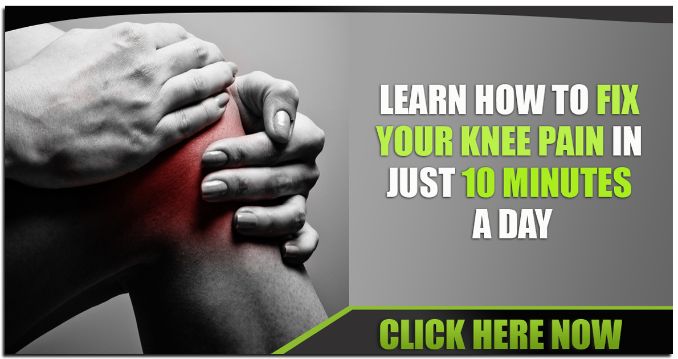Warming up your knees is essential for maintaining joint health and preventing injuries. Incorporating proper warm-up knee exercises enhances flexibility, reduces discomfort, and prepares muscles and tendons for physical activity, boosting workout performance.
Whether you’re getting ready for a run or workout or simply want to relieve knee stiffness, warming up can make a significant difference. In this guide, we’ll explore a variety of effective knee warm-up exercises and tips to help keep your knees healthy, strong, and injury-free.
Why Warming Up Your Knees is Important
Knee pain can be caused by a lack of flexibility or strength in the muscles of the legs and glutes. Sitting for long periods can lead to knee pain due to stiffened muscles and tendons.
Warm-ups [1] help your body sense the position and movement of your knees better, reducing the risk of injury during activities. Stretching, both static stretching (SS) and dynamic stretching (DS), improves your ability to control and position your knees accurately.
Causes of Knee Pain
Below are some causes of knee pain [2]:
- Patellofemoral Joint (PFJ) Issues: Pain happens when the kneecap (patella) doesn’t glide smoothly over the thigh bone (femur).
- Abnormal PFJ Loading: Misalignment of the knee joint puts extra pressure on the kneecap, causing pain.
- Component Malrotation: If parts of the knee are not properly aligned during surgery, it can throw off the kneecap’s position and cause discomfort.
- Lateral Tracking and Patellar Subluxation: Misalignment can cause the kneecap to move incorrectly, tilt, or partially pop out of place.
- Overstuffing the PFJ: If the knee replacement parts are too big, they can create too much pressure, leading to pain.
- Soft Tissue Problems: The tissues around the knee can become irritated or stretched, causing pain.
- Pain Receptors in Tissues: The tissues around the knee have sensors that trigger pain when damaged or stressed.
- Muscle Imbalance: Weak muscles can misalign the knee, putting extra strain on the kneecap and causing pain.
- Knee Joint Instability: An unstable knee can create abnormal forces, leading to discomfort.
- High Bone Pressure: Misaligned joints or poorly fitting knee parts can put too much pressure on bones, causing pain.
Best and Safe Knee Stretches for Flexibility
Regular stretching can help improve knee flexibility and alleviate pain. Everyone can progress with regular stretching, even if it’s just a little loosening up. Stretching can help ease achy knees and improve overall knee health.
1. Standing Hamstring Stretch
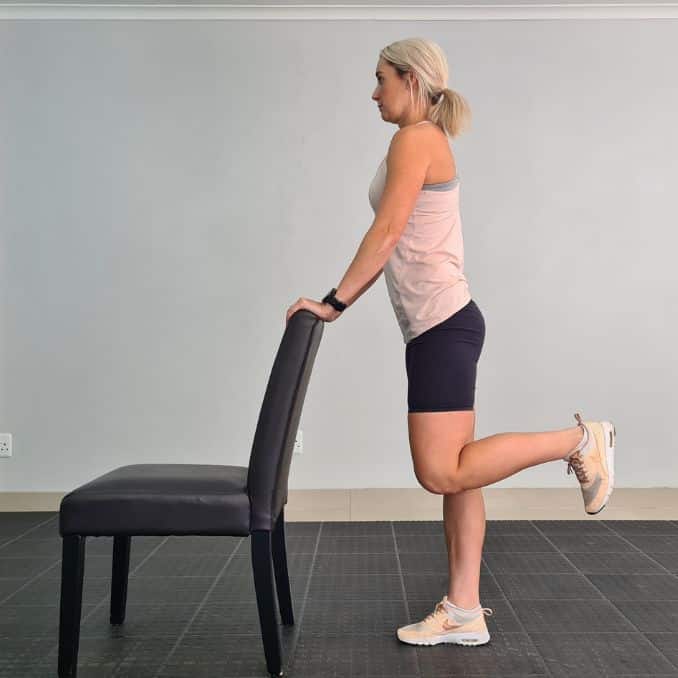
For this exercise, utilize the use of a chair for support.
- Begin in an upright standing position with your feet shoulder-width apart, maintaining good alignment with your head, shoulders, hips, and legs. Place your hands at the back of the chair for support. Engage your core. Bend one knee and bring your heel toward your glutes, keeping your knees close together. Hold this stretch for 15–30 seconds, release, and switch to your right leg.
2. Quad Stretch
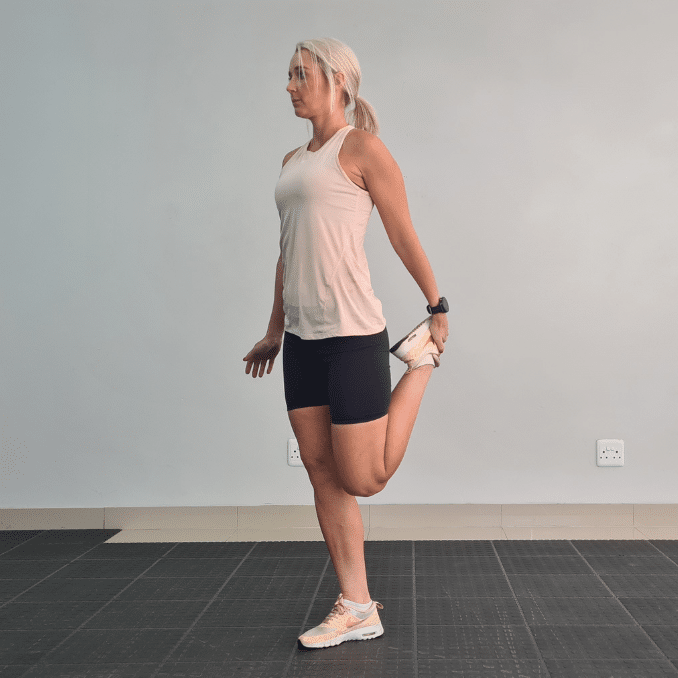
You may utilize a chair or a wall for support if balance is needed.
- Begin in an upright standing position with your feet shoulder-width apart, maintaining good alignment with your head, shoulders, hips, and legs. Engage your core. Bend one knee and bring your heel toward your glutes, grabbing your ankle with the same side hand. Keep your knees and chest upright as you gently pull your heel closer to your body. Hold the position with your one leg bent for 15–30 seconds, release, and switch legs.
3. Butterfly Stretch
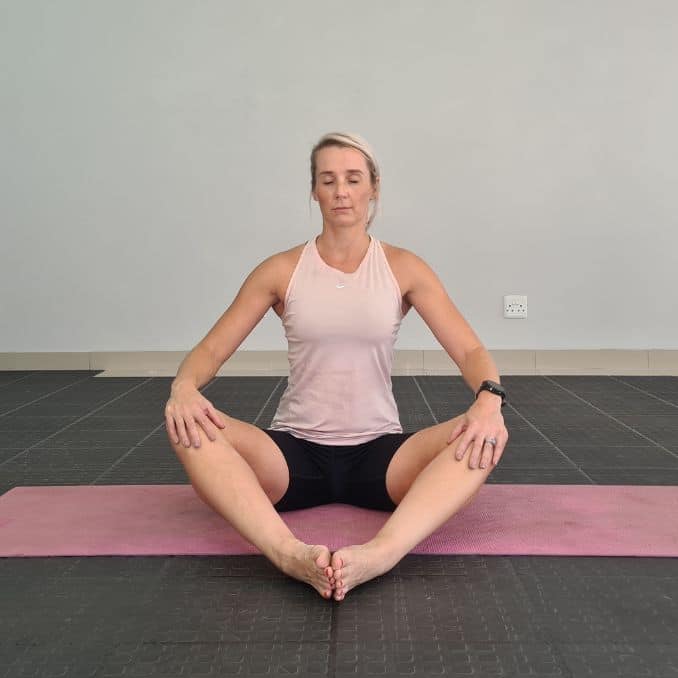
- Begin in an upright sitting position on the floor with your knees bent and feet flat on the floor. Maintain good alignment with your upper body. Engage your core and bring the soles of your feet together, spreading your knees out to the sides while keeping your spine straight. Place your hands on your knees for a deeper stretch. Hold the position for several deep belly breaths, through your nose and out through your mouth.
4. Knee-to-Chest Stretch
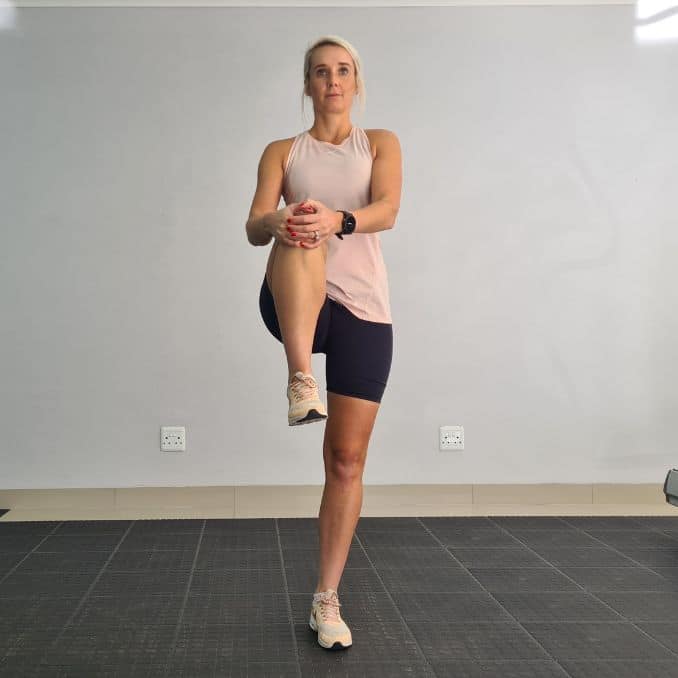
- Begin in an upright standing position with your feet hip-width apart, maintaining good alignment with your head, shoulders, and hips. Contract your core and lift one knee toward your chest, keeping your standing leg slightly bent for balance. Use both hands to gently pull your knee closer to your chest while keeping your back straight. Hold this position for several deep belly breaths, in through your nose and out through your mouth. Lower your leg and return to the starting position. Alternate legs and repeat the movement for 10–12 reps per side.
Dynamic Warm-Up Exercises for Knees
Dynamic stretching before exercise enhances muscle strength, speed, and agility, which are critical for activities like running and jumping.
1. High Knees

- Begin in an upright standing position with your feet hip-width apart, maintaining good alignment with your head, shoulders, hips, and legs. Engage your core and start jogging in place. Lift one knee toward your chest, keeping your foot off the ground while swinging the opposite arm forward for balance.
- Alternate legs, lifting each knee high as you pump your arms naturally. Keep a steady rhythm and engage your core throughout the movement. Perform this exercise for 20–30 seconds and then return to a standing position.
2. Walking Lunges

- Begin in an upright position with feet hip-width apart, and maintain good alignment with your head, shoulders, hips, and legs. Take a big step forward with your right leg. Engage your core and bend your right knee in a 90-degree angle to move into a lunge position while keeping your left leg extended straight behind you, with your toes tucked on the floor. Place both hands gently on your front knee for balance and maintain an upright posture. Hold the position for a few seconds, then raise back up before stepping your left leg forward as you repeat the movement sequence. Repeat the movement for 10–12 reps per leg.
Common Mistakes to Avoid in Knee Exercises
- Avoid overstretching or forcing your knees beyond a comfortable range of motion.
- Don’t neglect to warm up before exercising, as this can increase the risk of knee injury.
- Avoid putting too much pressure on your knees, and focus on gentle, controlled movements.
- Don’t forget to stretch after exercising, which can help alleviate muscle soreness.
Conclusion
A combination of general warm-up and dynamic stretching [3] provides the best results in enhancing performance and preventing injuries. Remember to always warm up before exercising and to focus on proper form and technique. Start with modified versions of exercises and gradually increase difficulty as form improves. Don’t stretch after exercising, and avoid putting too much pressure on your knees. If you experience persistent knee pain, seek medical attention and consider consulting a physical therapist.
Say goodbye to knee pain and get back to doing what you love! Discover the proven solutions for Knee Pain today and reclaim your mobility.
Frequently Asked Questions (FAQs)
Why is it important to warm up my knees before exercise?
Warming up increases blood flow to the knee joint, improves flexibility, and reduces the risk of injury during exercise.
What are the best warm-up exercises for knee pain?
Gentle exercises like leg swings, knee circles, lunges, and quad stretches can help relieve pain and prepare the knees for activity.
How long should I warm up my knees before working out?
Spend about 5-10 minutes warming up your knees with dynamic stretches and gentle movements before starting more intense exercise.
Can warming up my knees prevent injuries during exercise?
Yes, warming up helps increase joint mobility and muscle activation, which can prevent strains, sprains, and other knee injuries.
Are there exercises for people with knee arthritis?
Yes, low-impact exercises such as swimming, cycling, and gentle stretching can help strengthen the muscles around the knee and reduce pain.


